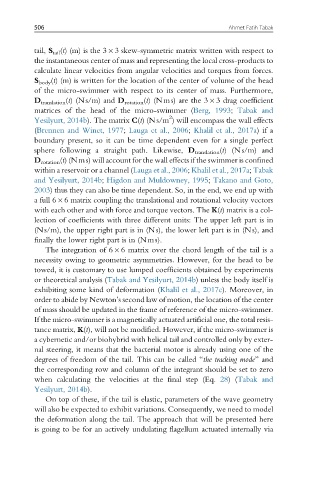Page 512 - Handbook of Biomechatronics
P. 512
506 Ahmet Fatih Tabak
tail, S tail (t) (m) is the 3 3 skew-symmetric matrix written with respect to
the instantaneous center of mass and representing the local cross-products to
calculate linear velocities from angular velocities and torques from forces.
S body (t) (m) is written for the location of the center of volume of the head
of the micro-swimmer with respect to its center of mass. Furthermore,
D translation (t) (Ns/m) and D rotation (t) (Nms) are the 3 3 drag coefficient
matrices of the head of the micro-swimmer (Berg, 1993; Tabak and
2
Yesilyurt, 2014b). The matrix C(t) (Ns/m ) will encompass the wall effects
(Brennen and Winet, 1977; Lauga et al., 2006; Khalil et al., 2017a)if a
boundary present, so it can be time dependent even for a single perfect
sphere following a straight path. Likewise, D translation (t) (Ns/m) and
D rotation (t) (Nms) will account for the wall effects if the swimmer is confined
within a reservoir or a channel (Lauga et al., 2006; Khalil et al., 2017a; Tabak
and Yesilyurt, 2014b; Higdon and Muldowney, 1995; Takano and Goto,
2003) thus they can also be time dependent. So, in the end, we end up with
a full 6 6 matrix coupling the translational and rotational velocity vectors
with each other and with force and torque vectors. The K(t) matrix is a col-
lection of coefficients with three different units: The upper left part is in
(Ns/m), the upper right part is in (Ns), the lower left part is in (Ns), and
finally the lower right part is in (Nms).
The integration of 6 6 matrix over the chord length of the tail is a
necessity owing to geometric asymmetries. However, for the head to be
towed, it is customary to use lumped coefficients obtained by experiments
or theoretical analysis (Tabak and Yesilyurt, 2014b) unless the body itself is
exhibiting some kind of deformation (Khalil et al., 2017c). Moreover, in
order to abide by Newton’s second law of motion, the location of the center
of mass should be updated in the frame of reference of the micro-swimmer.
If the micro-swimmer is a magnetically actuated artificial one, the total resis-
tance matrix, K(t), will not be modified. However, if the micro-swimmer is
a cybernetic and/or biohybrid with helical tail and controlled only by exter-
nal steering, it means that the bacterial motor is already using one of the
degrees of freedom of the tail. This can be called “the tracking mode” and
the corresponding row and column of the integrant should be set to zero
when calculating the velocities at the final step (Eq. 28)(Tabak and
Yesilyurt, 2014b).
On top of these, if the tail is elastic, parameters of the wave geometry
will also be expected to exhibit variations. Consequently, we need to model
the deformation along the tail. The approach that will be presented here
is going to be for an actively undulating flagellum actuated internally via

